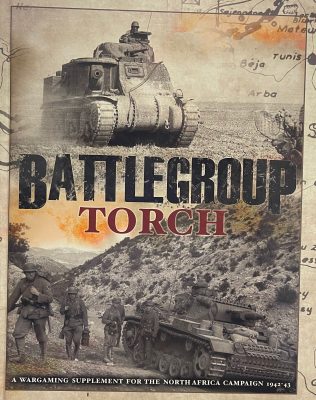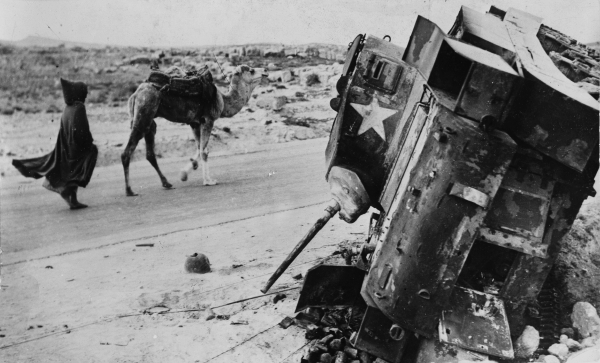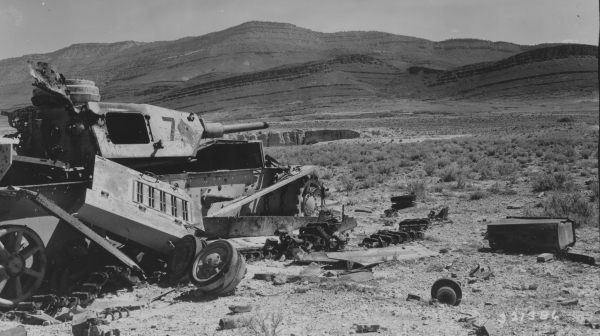First Blooding – A Battlegroup mini-campaign
 By Tom Gall
By Tom Gall
is a point to point mini-campaign that can be downloaded from the PSC website for 5.00 British Pounds or ~$7 USD. What you get is a 20 page PDF document that guides you through running the campaign for your players. It includes a 2 page theatre map. a very well written history of the situation as well as all the needed administrative items such as how to handle movement, setup battles and otherwise be an effective and fun referee. The campaign is geared for the Battlegroup [1] set of WWII rules.
Kasserine as you might remember took place in Feb of 1943 as the Germans were under increasing pressure from the East and West after the Torch landings. The Axis under Rommel had decided to direct an offensive at the largely untested Americans through the Kasserine Pass. Defending the area of the allies was the US II Corps, British 6th Armored Division as well as elements of free French.
For those looking to stitch together a series of games where the outcomes matter, a campaign such as this is a great choice. It presents your players with a series of actions based on their moves on the larger theatre map. Not all games will be equally balanced and this can test the will of a gamer having to play a tough defensive action where the odds are long. On the other hand, a campaign setting gives your players a focused setting where the fruits of their painting labor can see plenty of action on the table top.
The campaign takes place over Feb 19th-22nd 1943, which breaks down to 10 campaign turns. In addition there are 3 historical refights which to the victory award campaign victory points. They also help illustrate the reality of what some of the forces had to face as the historical action was happening. With 10 campaign turns, it’ll generate a number of games, but not something of such length that your players will be challenged to keep interest.

The joy of a point to point campaign is they make management of the map easier. Using historical maps and allowing players the ability to “go” anywhere requires a referee to put in substantial time and effort. While such maneuvering on map can be its own thrill it doesn’t necessarily help generate games. In a point to point campaign, players deploy their available forces as a series if chits. Each “chit” on the battlemap equals 250 points of a battlegroup force.
Chits represent certain forces and thus when building a force to the table top will be limited based on the list the chit represents. Additionally some chits have further limitations based on their historical force. For instance, no Tigers because they were not in use during Kasserine. Some forces are limited to certain types of tanks because that is what they hand. The force lists that the players use are pulled from the Torch Battlegroup book as such that is a requirement to play the campaign.

There is a “stacking” limit of 3 chits per location, which means that the maximum battle size is 750 points per side, however reinforcements are based on units that are in an adjacent locations. Each “chit” that is adjacent yields 150pts of reinforcements that will arrive on turn 3 if one movement point away, turn 6 if 2 movement points away and turn 9 if 3 movement points away. This system has worked well as our own group has been playing out the campaign. Giving the players points to field the force of their choosing, means game days are a little exciting as each side reveals what force selection has been made.
Battles are generated when a player moves into the same space as the enemy. If the size of the two forces is the same there is a battle neither side can withdraw, players don’t get an option. If one force size is smaller than the other, the player can decide to retreat without cost and thus avoid a lop sided battle. When a battle is played on the tabletop the loser will have to retreat from the location as well as losing a “chit”, so 250 points. While each side has around 15 counters each, a lose still has an impact.

What is each side playing for? Victory points of course, these are earned by winning battles, (the historical refights included), as well as holding locations on the map. Locations on the map are worth a variable amount, as much as 3 victory points to nothing at all. The tally is made at the end of the campaign to determine the winning side.
What forces are needed to play? The British, Germans, Italians, United States and Free French are all represented in the campaign. Typical game sizes will be at most 750 points a side plus reinforcements which makes for a perfect afternoon or evening gaming. As a reminder 750 points is a platoon level game in Battlegroup. An average force might be fielding a platoon of infantry, some number of tanks (3-5), some amount of recon, maybe a field gun, anti-tank gun or two and so on. Our group plays in 15mm, however 20mm is also very popular with Battlegroup. No matter the scale these are manageable games with a reasonable number of forces that even if you’re just getting started out in the hobby, they aren’t a terrible burden to paint and assemble.
Taking on a campaign is a bit of a commitment but for a group of players can offer a great set games linked together that will generate their own stories about brilliant tactics, terrible luck, and other glories on the tabletop, best shared with friends. These days, the cost of PDF is well worth the fun that it will yield. It is my hope that PSC generates more of these campaigns as they make rule sets like Battlegroup shine and inspire players to paint, field and play their armies.
[1] is a squad/platoon/company level miniatures game by the Plastic Solider Company. It is most often played in 15mm or 20mm. The rules are aimed at those looking for a historical experience on the tabletop.
